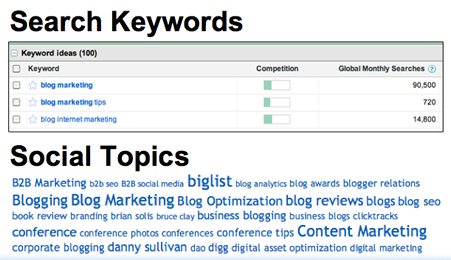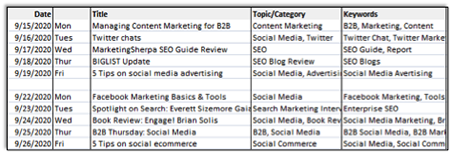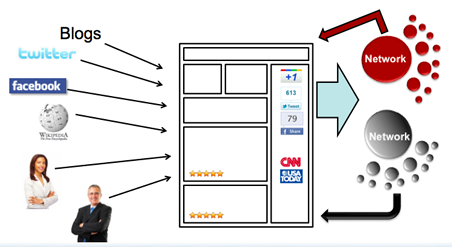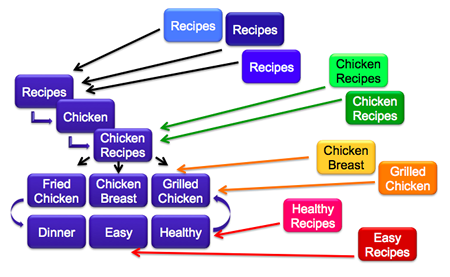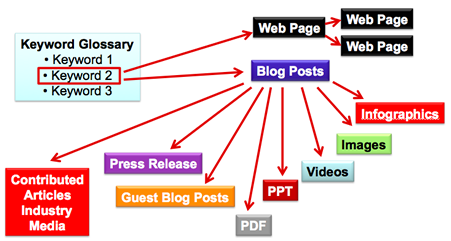Content marketing should not just be seen as placing random articles of text on your website and blog with the hopes of getting attention. If you can create quality content for your target audience that catches the attention of interested people, and they decide to share the content with their own community and network, you have succeeded in creating good content that will work for you. I found this article below on toprankblog.com, have a look.
All marketing efforts should start with a goal and means for measuring success, so I do not get into specifics on those tasks in this list, but focus more on the content and promotion.
1. Social SEO Personas
While blogging evolved out of personal expression, business blogging is less about corporate egocenticism and more about empathy with customers. Customer centric content for blogging is more relevant and does a much better job of engaging. In the way that direct marketers segment customers by key characteristics, online marketers that blog can create buyer personas to create more relevant experiences for their readers.
Personas are customer profiles (preferences for information discovery, consumption & sharing) that represent groups of customers that a brand wants to engage and do business with. Information from Personas drives keyword research & optimization, content plan and promotion. More about persona creation here. So one of the first things a blogger should do after defining objectives and general audience, is to understand who they’re trying to reach by developing personas.
Collect data through reader / customer surveys, analytics, social monitoring and other tools to form a profile. That profile represents topics, behaviors and preferences that can translate into search keywords, social topics, social channels, editorial calendar and promotion plans.
2. What is your unique selling proposition?
When people (or search engines) visit your website, is the primary topic crystal clear? With the increased competition in search and for attention in social conversations, it’s essential for blogs to stand out. Being able to articulate your Unique Selling Proposition helps distinguish your content the value of your blog content for people and search engines. The screenshot above shows a blog that is crystal clear in it’s focus. The result is reflected both in popularity and search visibility (#1) for highly competitive phrases like “digital photography“.
Developing a Unique Selling Proposition for your blog (h/t SEOBook) is pretty straightforward: Identify the key benefits of your blog’s content and how you will address customer/reader pain points. As you communicate your USP, be specific, concise & show proof. It’s also important to live your USP so that it’s a key component of your messaging.
3. Search & Social Media Keywords
Personas and your USP represent the intersection of customer interests and the goals for your blog. In order to activate your blog content for effective discovery via search and social media channels, it’s essential to create a search phrase keyword glossary for Search Engine Optimization purposes and a social media topic glossary for Social Media Optimization.
SEO Keywords: Resources like Google’s keyword research tool are a great start for finding which words and phrases are in demand, relevant to the content you’re publishing on your blog. It’s tempting to be egocentric and use whatever language you want, but if there is an expectation to attract significant search traffic and an interest in using language that resonates with a community in search of what you have to offer, keyword optimization of content is very appropriate.
Social Topics: Social topic tools that work like a SEO keyword tool are very rare and a to really get into useful source information, there’s a lot of manual research necessary. However, to get started, tools like socialmention.com offer a list of social keywords (bottom left of search results page) that can be downloaded as a CSV file for use in your Social Topic Glossary. Social keywords represent topics of interest to the people your blog is intended to reach and engage. By researching these topics and the specific language the community uses to express their interest, your blogging can be more effective at being relevant and shared on the social web.
The SEO Keyword and Social Topic glossary provide guidance towards editorial plans and specific phrases/topics can be mapped to content for search and social media optimization. It’s a great management tool that keeps SEO and SMO efforts accountable.
4. Create a Content/Editorial Plan
Keywords inform content and documenting an Editorial Plan for your blog can ensure that content is true to the goals of the business and interests of the community that reads it. An content plan also offers ideas and guidance, months in advance, which is priceless when bloggers hit creative roadblocks. This is inevitable, and after 7+ years of blogging myself, I can’t vouch enough for the guidance of an Editorial Plan.
Keep in mind, such a plan is a guide – not a set of hard and fast rules. It’s effective to schedule recurring themes with posts, like “Thought Leadership Monday”, “Practical Tips on Tuesdays”, “News Roundup on Fridays”. But it’s also important to allow for wildcards, because opportunities will come up spontaneously based on events within your company or the industry that require blogging. And you don’t want to delay publishing important news or a reaction to news, just because it wasn’t planned for that day.
The Editorial Plan defines the application of keywords in topics to be covered, categories, titles, tags and how/where/when the posts will be promoted. It also allocates for the future repurposing of appropriate blog posts.
5. Search & Social Media Optimization
Optimizing content for search on websites like Google and optimizing social content for ease of discovery and sharing within social channels is essential for reach and engagement of blog content. Optimizing for search & social media is the one two punch of blog marketing. If SEO efforts are initiated with an existing blog, then a SEO audit would be completed, including a review of the blog templates and configuration, existing content, internal links and links from other websites. If you’re starting a new blog, then SEO would be baked in to the editorial plan via the keyword glossary.
Optimizing for search is about helping search engines do a better job of connecting readers with your content. It’s not about tricks or manipulations. It’s about providing search engines and people what they need to find, consume and be inspired to share your blog content.
Optimizing for social media is about search as well, as in the search that’s possible within Facebook, LinkedIn, Twitter, YouTube, etc. But SMO is also about optimizing content editorially to resonate with social audiences. It’s about ease of discovery and sharing through things like feed distribution and widgets that make it easy to ReTweet or post to the reader’s favorite social sites.
SEO and SMO are about making life easy for both search engines and people to connect with, interact and share your blog content.
6. Links: Internal and External Acquisition
Links between pages and links acquired from relevant websites in the industry provide a good user experience and strong signals for search engines when they crawl, index and rank web pages. Following best practices for internal linking is one of the most impactful things a blog can do to help website realize SEO benefit. For example, a tips blog that cross links the keywords relevant to specific products being sold gives readers and search engines a quick and relevant way to move from editorial about how to use and get benefit from a type of product to a page that actually sells the product.
Attracting links from other relevant websites as pictured in the diagram above is essential for attracting new visitors to your blog, directly and indirectly because of the effect relevant links have on search engine visibility. What’s important to remember is that links to your blog home page are important, but relevant links into specific category or individual blog posts is essential External link sources that are relevant to broad topics that link to your home page or category pages provide the user (and search engine) with a very relevant connection. Links from niche sites to your specific blog posts do the same.
There are myriad ways to attract links for blogs ranging from commenting and guest posting to creating content that attracts links from other bloggers and the media.
7. Content Promotion
Content isn’t great until it gets shared. A lot. That doesn’t mean a blogger should aggressively promote every post. It does mean that when a particular post is especially promotable (you would know this because you planned for it in your Content Plan) then it warrants special attention. Blog content can be promoted in a variety of ways and effective promotion is tied to the quantity and quality of the networks you’ve built. That includes readers and subscribers of your own blog, an email list, Facebook Fan page, Twitter, LinkedIn and other relevant sites where people with common interests interact and share.
Some content promotion is automatic, like RSS feeds, syndication of blog posts to Twitter, Facebook and LinkedIn or content syndication partnerships. Other content promotion might be tied to the content itself, like using industry thought leaders to crowdsource insights into a topic (your keywords) of importance to your readers. Those participants will often help you promote the post. You can also reach out to your network and suggest or share relevant posts they might be interested in. Commenting and being social on/offline are also effective promotion methods.
The bottom line with content promotion is that great content that isn’t promoted vs. mediocre content that is promoted in a relevant way, will often lose in terms of traffic and therefore meaningful engagement with a greater number of readers. The amount of content being published on a daily basis creates levels of competition never before experienced, so promotion is essential to stand out and get noticed. But it has to be content that’s WORTH promoting.
Summing it all up.
The implementation and refinement of these steps is a work in progress. The web continues to change in terms of technology and how people use it. It’s essential that companies follow an adaptable online marketing strategy when focusing on the social web and search engines. Opportunities will reveal themselves in web analytics and social media monitoring and the promotion efforts outline above apply to those real-time marketing situations just as well as tasks included in a Content Plan. Hopefully these guidelines are useful to you and if you need more specific information, you’ll likely find it in blog posts we’ve published in the past. At TopRank Marketing we do this kind of consulting on a daily basis so there’s a lot of rich information published in our archives.
What other types of insight about blogging and blog marketing would you like to see? What are some of the biggest obstacles you’ve had (and maybe overcome) when it comes to implementing blog marketing tactics like those mentioned in this post?


